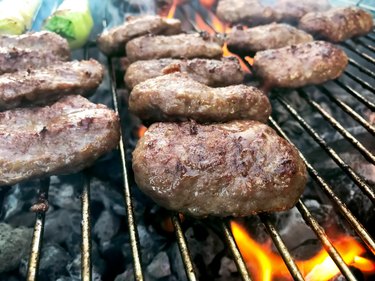
Some cholesterol is bad, some is good. Too much of one type can cause heart disease, but too little of another kind can also raise heart disease risk. And what about triglycerides? Bottom line? Cholesterol can be confusing. Let's look at what cholesterol does and why it can be harmful or helpful.
What Exactly Is Cholesterol?
Video of the Day
Cholesterol is a type of fat found in the body. You need some of all types of cholesterol to survive. It's used to build the body's cells. But too much of some types of cholesterol can be a problem, increasing the risk for heart and blood vessel disease, the American Heart Association (AHA) says.
Video of the Day
Cholesterol is primarily made in the liver. Humans also get cholesterol from some food sources, mostly meat and full-fat dairy. Those foods also contain saturated and trans fat that prompt the liver to make more cholesterol than it normally does, the AHA explains.
The three measurements your doctor is most often concerned are for LDL (low-density lipoprotein) and HDL (high-density lipoprotein) cholesterol, as well as triglycerides, the AHA notes.
The Lowdown on LDL
LDL is considered the "bad" cholesterol. If you have too much LDL cholesterol, the excess collects on the walls of your blood vessels. Eventually these deposits can lead to narrowed blood vessels, which can increase your risk for a heart attack or stroke.
Peter Mercurio, MD, a cardiologist from Northern Westchester Hospital in Mount Kisco, New York, notes that cholesterol levels vary by age and sex, and whether they're considered normal or not varies by which organization is setting the recommendations. Generally, he says, an LDL level of above 130 milligrams per deciliter is concerning.
The NHLBI suggests keeping LDL cholesterol under 100 milligrams per deciliter or most people. If you already have an increased risk for heart disease or have diabetes, the NHLBI recommends getting LDL below 70.
How to do that? If your LDL levels are higher than recommended, Dr. Mercurio says that dietary changes can help. Lose weight, exercise and don't eat a lot of red meat, he says. People with high LDL often need medication, he adds. Avoid foods that are high in saturated and trans fat as they tend to raise LDL cholesterol levels.
Understanding HDL, the 'Good' Cholesterol
HDL is considered the "good" type of cholesterol. Women generally have higher levels of HDL, and that's good — with HDL you want higher, not lower, levels. A number of factors can lower HDL levels, including smoking, excess weight, too little physical activity and type 2 diabetes. Your genes can also influence your HDL levels, according to the AHA.
Most adult men are advised to have an HDL level above 40 milligrams per deciliter. For adult women, that target is 50 or higher, according to the National Heart, Lung, and Blood Institute.
Dr. Mercurio recommends exercising more often to raise your HDL levels. The NHLBI says that losing weight and managing stress also may improve HDL levels.
Read more: How to Raise Good Cholesterol Numbers
Think Triglycerides, Too
Triglycerides are another type of blood fat that can increase your risk for a heart attack or stroke, the NHLBI says. According to the AHA, factors that can boost your triglyceride levels are:
- Eating a high-carbohydrate diet (more than 60 percent of calories from carbohydrates)
- Drinking too much alcohol
- Having overweight or obesity
- Smoking
- Not getting enough exercise
Genes can also play a role in triglyceride levels.
Normal levels for adult men and women are below 150 milligrams per deciliter. Choosing healthier lifestyle habits, such as quitting smoking, losing weight and exercising more can improve triglyceride levels, the NHLBI says.
What About 'Total Cholesterol'?
If you've ever looked at your cholesterol tests results in detail, you may have noticed that the "total" number doesn't seem to equal all of the other measurements combined. That's because your total cholesterol includes your LDL and HDL cholesterol levels, and 20 percent of your triglyceride score, according to the AHA.
The NHLBI says that adults should have a total cholesterol level somewhere between 125 and 200 milligrams per deciliter. So if your total cholesterol is 260, for example, that would be considered high — but there are treatments and lifestyle changes that can bring that down, so work with your doctor on a plan that will be best for you.
Read more: What's a Healthy Cholesterol Ratio?
- American Heart Association: "Control Your Cholesterol"
- National Heart, Lung, and Blood Institute: "High Blood Cholesterol"
- Peter Mercurio, MD, cardiologist, Northern Westchester Hospital, Mount Kisco, New York
- American Heart Association: "What Your Cholesterol Levels Mean"
- National Heart, Lung, and Blood Institute: "High Blood Triglycerides"
Is this an emergency? If you are experiencing serious medical symptoms, please see the National Library of Medicine’s list of signs you need emergency medical attention or call 911.